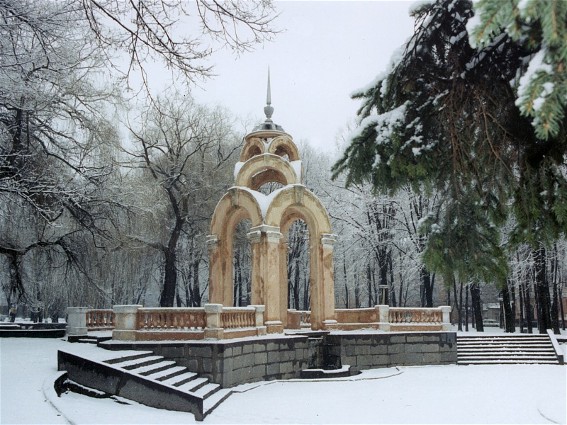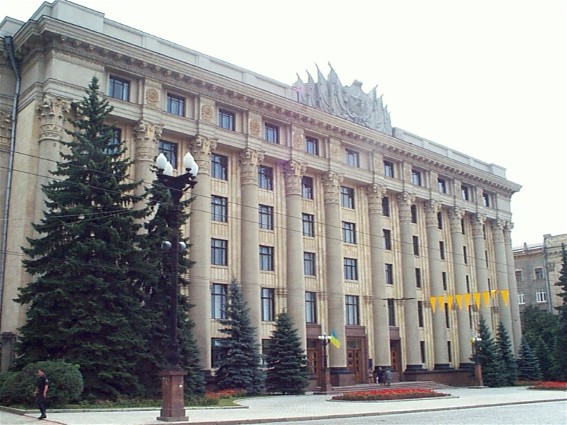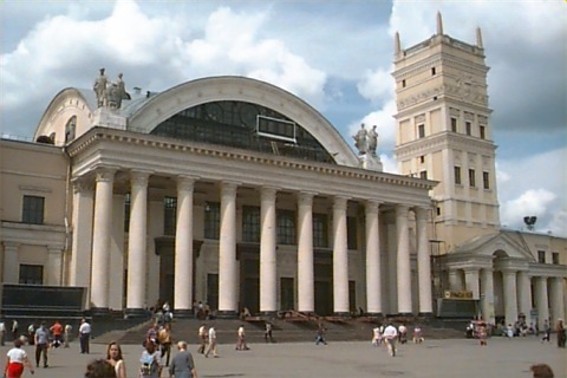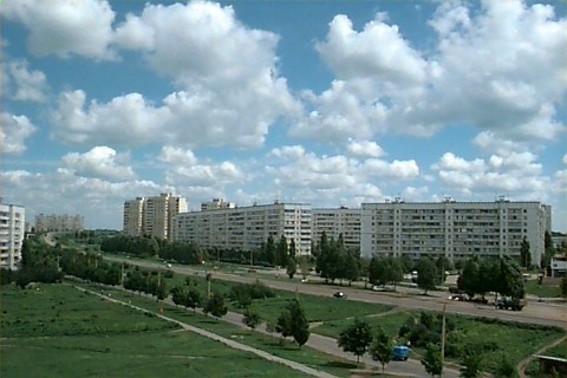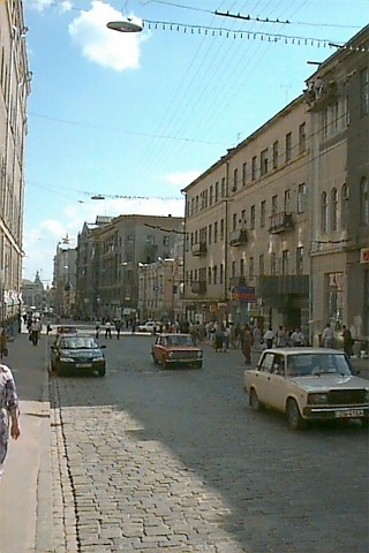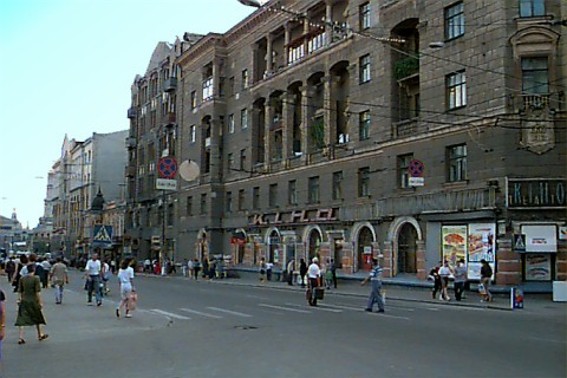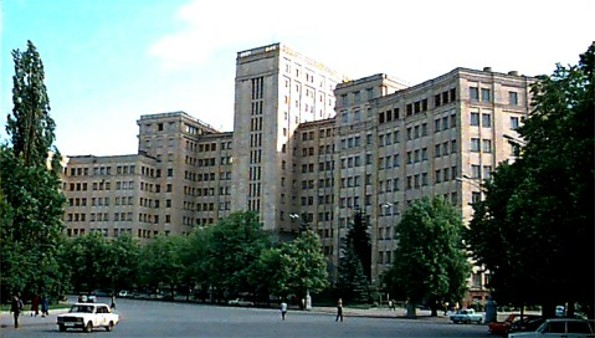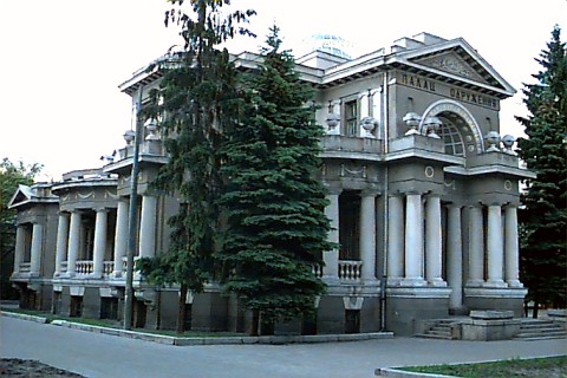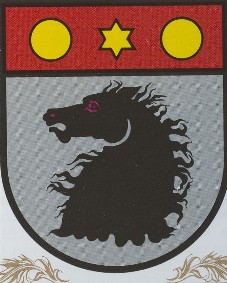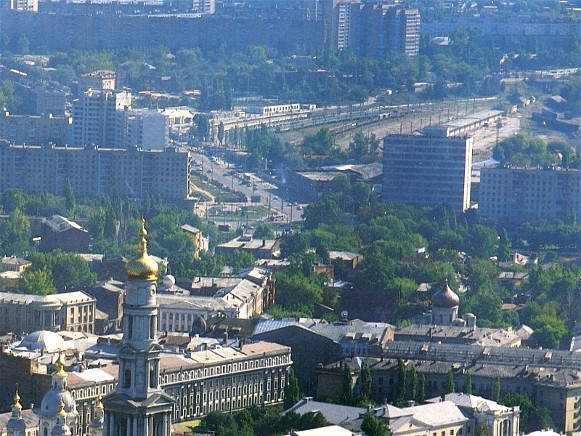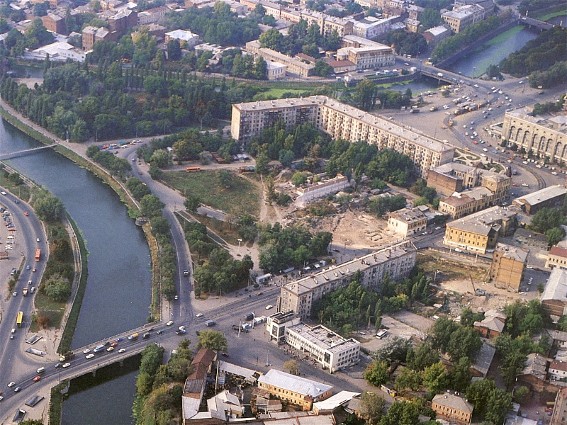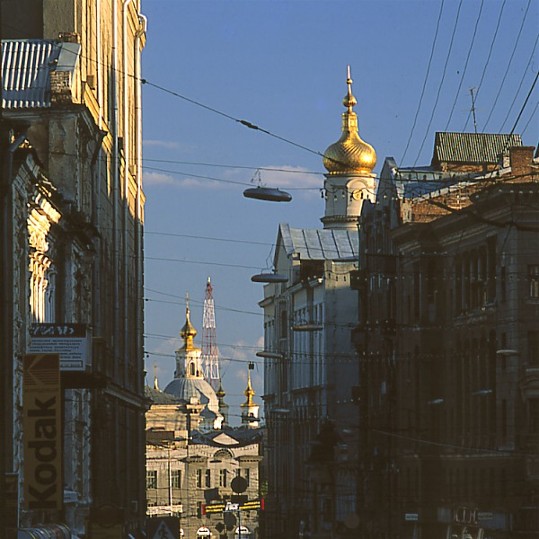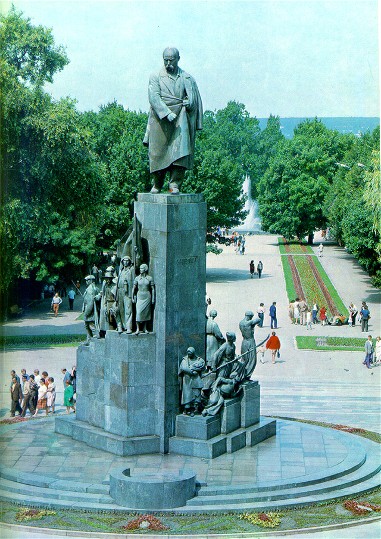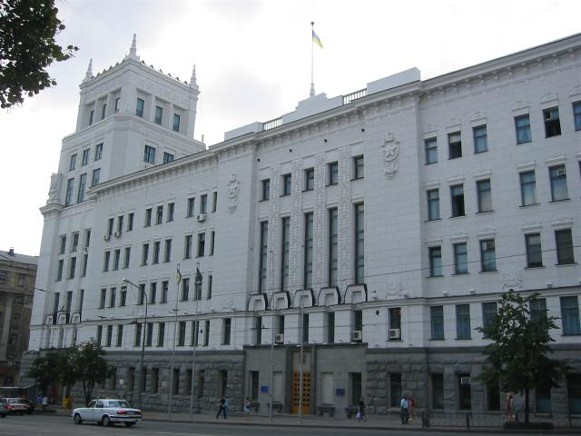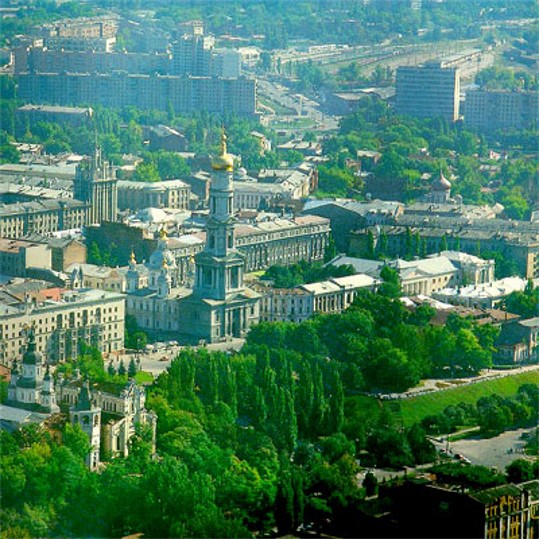Kharkiv
Kharkiv [Харків; Xarkiv]. Map: III-17. (Photo: Kharkiv panorama.) Ukraine's second-largest city (2005 pop 1,465,000) and the capital of Kharkiv oblast, situated at the confluence of the Lopan River, the Udy River, and the Kharkiv River. The historic capital of Slobidska Ukraine, it is an important industrial, commercial, communications, scientific, and cultural center. From 1920 to 1934 it was the capital of Soviet Ukraine. Kharkiv's proximity to the Donets Basin and its location at the intersection of the trade routes between Russia and the Black Sea and central Ukraine and Caucasia have facilitated its economic growth. The city is over 300 sq km in area and is divided into nine raions: Chervonozavodskyi, Dzerzhynskyi, Frunzenskyi, Kominternivskyi, Kyivskyi, Leninskyi, Moskovskyi, Ordzhonikidzevskyi, and Zhovtnevyi.
Kharkiv's name is most likely derived from the Kharkiv River. The Russian historian N. Aristov believed it was derived from the principal Cuman settlement of Sharukan, which existed near the present-day city. According to popular legend, the city is named after a Cossack, Kharko.
History. Kharkiv's vicinity has been settled since the 2nd millennium BC. Bronze Age settlements, Scythian kurhans (6th–3rd centuries BC), and Sarmatian relics (2nd–1st centuries BC) have been excavated there. Relics of the Cherniakhiv culture (2nd–5th centuries AD) have been unearthed in the city, followed by settlements of the Siverianians (8th century); their fortified settlement of Donets (dated from the10th century) has been excavated nearby.
From the 13th to the 17th century the large territory around present-day Kharkiv became wild steppe dominated by the Cumans and then by the Tatars. From the early 17th century the territory belonged formally to Muscovy, which stationed frontier garrisons there and sent out scouts and explorers to reconnoiter and map the region. Later, networks of fortifications against the Crimean Tatars and the Nogay Tatars—the Belgorod line, the Izium line, and the Ukrainian line—were built and settled, mostly by Ukrainian Cossacks, and non-serf villages (slobody, hence the name ‘Slobidska Ukraine’) and more numerous settlements of refugees from the war-torn Hetman state, Right-Bank Ukraine, and Western Ukraine sprang up. By the mid-17th century several such settlements existed in Kharkiv's vicinity.
The generally accepted date of Kharkiv's founding is 1654/5, when Ukrainian Cossacks led by I. Karkach built a fortified settlement on the plateau surrounded by the Kharkiv River and the Lopan River. A fortress was completed in 1659. Although they were formally under the jurisdiction of a Muscovite military governor, as military frontiersmen the Cossacks were allowed to be self-governing, according to ‘Cherkessian custom,’ with the right of free settlement, enterprise, and trade, until the reign of Peter I. In 1655 the population of Kharkiv was about 2,000, including about 600 Cossacks.
For the remainder of the 17th and most of the 18th century Kharkiv remained a defensive outpost; the Russian garrison and artisans and merchants lived within the fortress, but most of the Cossack population lived in nearby expanding slobody and engaged in farming, fishing, beekeeping, and barter trade. >From 1659 to 1765 Kharkiv was the capital of Kharkiv regiment, one of the largest Cossack administrative and military units in Slobidska Ukraine. In 1660–2 a new citadel, with administrative buildings (a governor's house) and churches, was built.
18th century to 1917. By the 18th century, the outside fortress had expanded beyond the rivers Lopan and Kharkiv. Alarmed by Hetman Ivan Mazepa's uprising and the rebellious Don Cossacks during the Russian-Swedish War, Peter I had Kharkiv's fortifications enlarged in 1708 and imposed restrictions and taxes on the Cossack population.
In 1724 the town had 61 streets and 1,300 courtyards. In 1732 its male population was 3,700, 2,500 of whom were Cossacks. As the borders of the Russian state shifted southward, the town changed gradually from a military outpost into a trading center. But Tatars still attacked the fortress (12 times between 1672 and 1738) and devastated the slobody. Russia's wars with Turkey, Sweden, and Poland drained the town of its Cossack population and burdened it economically. Much of Kharkiv was destroyed by a fire in 1733, and its population was decimated by plague in 1738 and 1741. Nonetheless the town revived and grew because of its economically advantageous location, which facilitated its advancement as a cultural center. Kharkiv's annual fairs (four in the 18th century and five in the 19th) attracted increasingly more merchants not only from Kyiv but also from the Baltic region, central Russia, the Crimea, Poland, Silesia, Moldavia, and Germany. Kharkiv College was founded in 1734; until the founding of Kharkiv University in 1805, it was the best educational institution in Slobidska Ukraine. In 1789 two public schools were opened.
After the Russian government abolished the Cossack regimental system in Slobidska Ukraine in 1765, Kharkiv served as the capital of Slobidska Ukraine gubernia (1765–80, 1796–1835), Kharkiv vicegerency (1780–96), and Kharkiv gubernia (1835–1925). From 1835 to 1882 it was also the seat of the governor-general of Kharkiv gubernia, Poltava gubernia, and Chernihiv gubernia. The social differentiation that had begun in Kharkiv and the frontier society of Slobidska Ukraine in the 17th century accelerated greatly in the late 18th: the Cossack starshyna was incorporated into the Russian nobility, the rank-and-file Cossacks were reduced in status to military settlers equal to state peasants, and hitherto free peasants became serfs. The merchants and petty artisans organized themselves into Russian-type guilds and emerged as distinct classes.
Under the governors and vicegerents (to whom the city administration was subject from 1787) Kharkiv was developed according to imperial standards of urban architecture, which were set in Saint Petersburg. New government, commercial, and private stone buildings were erected, some of them—the Cathedral of the Holy Protectress (1689), the governor's house (1766–77), the stone office building (begun in 1785), and the Dormition Cathedral (1783)—within the fortified town. From 1776 to 1810 Petro Yaroslavsky designed many of the city's buildings.
In 1799 Kharkiv eparchy was constituted. From the reign of Tsar Paul I (1796–1801) to the 1890s, Kharkiv was also the center of a military district, with a high concentration of military personnel and their families. After the legal reforms of 1867, Kharkiv became the seat of a high court whose jurisdiction exceeded the gubernia's boundaries.
With the founding of Kharkiv University and the university press in 1805 (through the efforts of Vasyl Karazyn and Kharkiv's Ukrainian nobility), the city also became an important educational and publishing center in Ukraine and the Russian Empire as a whole. In the 19th century four boys' gymnasiums, six secondary schools, a Realschule, a post-secondary veterinary institute (est 1873, replacing a veterinary school founded in 1839), a post-secondary technological institute (1885), and secondary commercial, technical, skilled-trade, agricultural, railway, music, art, and zemstvo midwifery schools were opened in the city. By the turn of the 20th century there were 60 societies there, including a philotechnical (1811), scientific (1813), Bible (1816), folklore (1817), philanthropic (1843), medical (1861), Red Cross (1876), Orthodox missionary (1876), and orphanage society (1874). The Kharkiv Literacy Society (1869) was one of the most successful of its kind in Ukraine. The city also had an art school (1861), stock exchange (1867), opera house (1874), music school (1883), museum (1886), and public library (1886). A nobles' assembly (1815–20), military academy (1825–8), theater (1840–3), technological institute (1879–85), duma building (1885), and many new commercial and private buildings were constructed. From the 1890s to the 1930s the architect Oleksii Beketov designed many of the city’s important buildings. In 1913 Konstantin Zhukov built the art school building in the so-called Ukrainian style.
Until the 20th century Kharkiv’s municipal services were inadequate, and it was known as a dirty, polluted city. Until the 1830s its streets were unpaved and impassable in wet weather. The water from the rivers running through the city was undrinkable; an aqueduct was built only in 1881 and enlarged in 1912–13, when a water tower supplying the main streets was erected. Residents of side streets and suburbs had to rely on wells for their water. Medical care was also inadequate. In 1878 there were only four hospitals in the city; in 1901 there were only eight hospitals and 390 doctors.Construction of a sewage system was begun only in 1912. Gas lighting was introduced in the 1880s, and electric lighting in 1898 (on the city's outskirts). From 1882 a horse-drawn trolley line, which from 1886 was owned by a Belgian stock company, operated on the central streets. The first tramway was laid in 1906.
The city's population grew almost twentyfold in the 19th century: from 11,000 in 1787 to 23,000 in 1837, 35,600 in 1856, 50,300 in 1861, 128,500 in 1881, 174,000 in 1897, 198,300 in 1901, and 244,700 in 1914. Most of the increase after 1861 was due not to natural growth, but to municipal annexation and particularly the influx of Russian workers, merchants, tradesmen, and civil servants. According to the 1897 census, over two-thirds of Kharkiv's residents were born in Ukraine. Because of the impact of Russification, however, only 25 percent of the residents stated that the Ukrainian language was their native language.
In 1855 Kharkiv had 212 small primitive manufacturing enterprises with a total of 4,256 workers (2,460 of them serfs) producing carriages, bricks, beer, tanned leather, wool, tobacco, soap, wax, rendered fat, wadding, copper and iron goods, lead shot, consumer items, and vegetable oil. Kharkiv's industries and commerce expanded rapidly after the emancipation of the peasants, and particularly after the railway reached the city in 1868. Between 1871 and 1900 the number of factories and plants increased from 79 to 259 (the number of machine-building and metalworking plants rose from 12 to 59). In 1900 there were over 12,000 workers and 22,700 artisans in the city. By 1904 there were 106 officially registered factories and 1,112 lesser enterprises employing a total of 17,000 workers. In 1917 there were over 150 factories and over 35,000 workers. Because of primitive working and living conditions, economic exploitation, and political oppression, workers' unrest was a common occurrence in Kharkiv from the 1870s.
From the 1810s Kharkiv was an important center of the Ukrainian cultural renaissance. Many of the first Ukrainian linguistic, ethnographic, historical, and modern literary works were published there. Published also were the first periodicals in Russian-ruled Ukraine: the weekly newspaper Khar'kovskii ezhenedel'nik (1812), the satirical journal Khar'kovskii demokrit (1816), the cultural-political monthly Ukrainskii vestnik (Kharkiv) (1816–19), the weekly Khar'kovskiia izvestiia (1817–23), the agricultural journal Ukrainskii domovod (1817), and the scholarly-literary journal Ukrainskii zhurnal (1824–5, at Kharkiv University). Important 19th-century Ukrainian cultural figures lived and worked in Kharkiv: Hryhorii Kvitka-Osnovianenko, Petro Hulak-Artemovsky, Levko Borovykovsky, Izmail Sreznevsky, Mykhailo Petrenko, Oleksander Korsun, Amvrosii Metlynsky, Yakiv Shchoholiv, and Mykola Kostomarov; many of them belonged to the Kharkiv Romantic School. Several of the earliest Ukrainian almanacs were also published in Kharkiv: Ukrainskii al'manakh (1831), Utrenniaia zvezda (1833), Ukrainskii sbornik (1838, 1841), Snip (1841), and Molodyk (1843–4). Russian newspapers in Kharkiv— Khar'kovskiia gubernskiia vedomosti (1838–1915), Khar'kovskiia eparkhial'nyia vedomosti (1867–83), Khar'kov (1877–80), Iuzhnyi krai (1880–1917), and Khar'kovskii listok (1898–?)—also covered developments in Ukrainian cultural life. By the turn of the 20th century, 3 dailies and 16 other periodicals were being published in Kharkiv.
The first professional theater troupe in Ukraine was established in Kharkiv in 1789, but it was not until 1842 that Ludvig Mlotkovsky opened a theater building there. Hryhorii Kvitka-Osnovianenko directed the Kharkiv theater in 1812–18 and staged his plays there. Mikhail Shchepkin, Ivan Dreisykh, and Karpo Solenyk and the Shtein troupe (1823–36) appeared on the Kharkiv stage. The earliest Ukrainian plays were performed in Kharkiv, including the original production of Ivan Kotliarevsky's Natalka Poltavka (Natalka from Poltava) in 1821. In the 1880s and 1890s the Ukrainian troupes of Marko Kropyvnytsky, Mykola Sadovsky, Panas Saksahansky, and Mariia Zankovetska performed in Kharkiv, and in 1901 Hnat Khotkevych organized the first Ukrainian workers' theater there. Ukrainian cinema originated in Kharkiv in the late 1890s, with the short documentaries of Alfred Fedetsky. Many artists lived in Kharkiv, including Dmytro Bezperchy, Serhii Vasylkivsky, Mykhailo S. Tkachenko, Mariia Raievska-Ivanova, Mykhailo Berkos, Petro Levchenko, Ivan Sokolov, and Mykola Samokysh. In 1906 an art society was founded there.
Various revolutionary groups had adherents in Kharkiv. In 1856–8 the Kharkiv-Kyiv Secret Society was active in the city, as were cells of the clandestine anarcho-populist organizations Zemlia i Volia and Narodnaia Volia, beginning in the 1860s. Khrystyna Alchevska, the wife of the Kharkiv industrialist Oleksii Alchevsky, funded and ran the famous Kharkiv Women's Sunday School from 1862 to 1919, until 1870 secretly. The liberal members of the region's zemstvos conducted legal, educational, medical, agronomic, co-operative, and social work among the masses from 1864; in 1878 a secret zemstvo conference took place in Kharkiv. From the 1890s various Marxist socialist groups and cells of the Russian Social Democratic Workers' party were active in the city. At the turn of the 20th century and during the Revolution of 1905, the Mensheviks organized and led workers' strikes and demonstrations; they were the most popular of the revolutionary groups.
Kharkiv's Ukrainian intelligentsia (eg, P. Lobko, Oleksander Potebnia, Vasyl Mova, and F. Pavlovsky) was involved in the secret Kharkiv Hromada from the early 1860s (see Hromadas). From 1906 to 1916 the Kvitka-Osnovianenko Ukrainian Club (later the Prosvita society) was active in the city, and a co-operative publishing house published books in Ukrainian. Members of gentry families of Cossack starshyna descent—the Donets-Zakharzhevskys, Shydlovskys, and Alchevskys, to name a few—contributed much to the economic and architectural development of the city. Mykola Mikhnovsky, a lawyer in Kharkiv, was one of the founders of the clandestine Brotherhood of Taras; his advocacy of a program for an independent Ukraine resulted in the founding of the Revolutionary Ukrainian party at a Kharkiv student meeting in 1900. In 1906 the Ukrainian-language newspaper for peasants, Porada (ed M. Lobodovsky), came out in Kharkiv. Other prominent Ukrainian scholars and civic and literary figures lived in Kharkiv in the late 19th and early 20th centuries: Dmytro Bahalii (later the university’s rector and head of the city council), Mykola Sumtsov, Dmytro Yavornytsky, Ivan Bilokonsky, Ivan Manzhura, Pavlo Hrabovsky, and Borys Hrinchenko.
1917–20. After the February Revolution of 1917, Kharkiv was briefly governed by the gubernial commissioner of the Russian Provisional Government, the city duma, and the zemstvos. Workers' councils dominated by Mensheviks and Russian Socialist Revolutionaries attempted to seize power, particularly after the October Revolution of 1917. Many of the Ukrainian residents supported the Central Rada in Kyiv; to influence developments in the Russified city and to provide leadership for the Ukrainian population of the region, they held a congress and formed a Ukrainian Gubernial Council, headed by a man called Rubas, in late April 1917. A gubernial peasant congress was held in June, and a congress of Slobidska Ukraine's Prosvita societies was held in Kharkiv in August. A Ridna Shkola society was created to promote the Ukrainianization of elementary schools. New Ukrainian newspapers—the weekly Ridne slovo, the Social Democratic triweekly Robitnyk, and the socialist daily Nova hromada—appeared in 1917–18.
The first two universals of the Central Rada did not explicitly extend the Rada’s authority to the Kharkiv region, but the Third Universal (7 November 1917)—which proclaimed the creation of the Ukrainian National Republic—did so without defining the republic's borders, and Ukrainianized regiments were stationed in the city.
Kharkiv's proximity to Russia proper and to the Donbas, which were both under Bolshevik control, sealed the city's fate. In late November 1917 units of Russian Red Guards and Bolshevized sailors from the Baltic region reached the city. On 10 December, with the help of local Bolsheviks, they disarmed the UNR and Russian anti-Bolshevik troops there. On 24–25 December an All-Ukrainian Congress of Soviets convened in Kharkiv. It elected a Soviet government of Ukraine—the People's Secretariat—which remained there until February 1918, when the city became the capital of the Donets–Kryvyi Rih Soviet Republic. German units and the UNR Zaporozhian Division under Petro Bolbochan's command took Kharkiv from the Bolsheviks on 19 April 1918, and Col Oleksander Shapoval was appointed the gubernial commander there. Many local Ukrainians joined the Zaporozhian Division that grew into the Zaporozhian Corps.
Under the Hetman government a gubernial starosta, Petro Zalesky, resided in Kharkiv until 2 July 1918, when he was removed for his anti-Ukrainian actions. The Hrinchenko Gymnasium (directed by Mykola Plevako) was set up and other schools were Ukrainianized, but the government shut down the opposition newspaper Narodne dilo. In November 1918 the city was taken by troops of the Directory of the Ukrainian National Republic. On 3 January 1919, however, it was recaptured by the Red Army. On 25 June Gen Anton Denikin's Volunteer Army occupied the city and held it until 11 December 1919.
1920–41. After the Red Army defeated Gen Denikin, Kharkiv became the capital of Soviet Ukraine. The All-Ukrainian Central Executive Committee, the Council of People's Commissars, and the central offices of the Communist Party (Bolshevik) of Ukraine, people’s commissariats, trade unions, and republican organizations and periodicals were located in Kharkiv from 1920 to 1934. Central co-operative institutions were also based there until they were shut down in the early 1930s. In the early 1920s some diplomatic missions and consulates were opened in the city. The Ukrainian Autocephalous Orthodox church flourished in Kharkiv from 1923 to 1926, when Archbishop Oleksander Yareshchenko was arrested by the GPU. As part of the policy of Ukrainization, post-secondary Soviet schools, including the Kharkiv Institute of People's Education (1921–30), the Institute of the National Economy, and the Artem Communist University, were Ukrainianized in the 1920s.
Because of frequent reorganization, the number of postsecondary schools in Kharkiv grew, from 10 in the early 1920s to 23 in 1931 and 36 in 1940 (with an enrollment of 31,000). In 1926 some faculties of the old Technological Institute were reorganized into separate machine-building, chemical-technology, and electrotechnical institutes; after the Second World War these were amalgamated to create the Kharkiv Polytechnical Institute. Kharkiv University, which was abolished in 1920, was reopened in 1932. The Ukrainian School of Red Officers was opened in Kharkiv in 1920; it was closed down in the early 1930s with the abandonment of Ukrainization.
From 1920 to 1934 many important scientific institutions were located in Kharkiv: the Scientific Committee of Ukraine, the Agricultural Scientific Committee of Ukraine, the Central Historical Archive, the Central Statistical Administration of Ukraine, the Central Archival Administration of the Ukrainian SSR, the All-Ukrainian Agronomic Society, the All-Ukrainian Association of Oriental Studies, and the All-Ukrainian Association of Marxist-Leninist Scientific Research Institutes. Important contributions to Ukrainian studies were made by the scholars of the Ukrainian Scientific Research Institute of Geography and Cartography, the Scientific Research Institute of the History of Ukrainian Culture, the Department of the History of Ukraine, and the Taras Shevchenko Scientific Research Institute. Most of these scholars became victims of the Stalinist Terror.
A number of museums were opened, including the All-Ukrainian Historical Museum, the Museum of Slobidska Ukraine, the Museum of Social Culture, and the Museum of Ukrainian Art (see Kharkiv Art Museum). Large publishing houses, such as the State Publishing House of Ukraine, Proletarii, and Radianskyi Selianyn, and the co-operative publishers Knyhospilka and the Rukh publishing house (which were closed down eventually), were located there. The Book Chamber of the Ukrainian SSR ran a wide range of operations. Important artists' and writers' associations—Pluh, Hart, Vaplite, Nova Generatsiia, the All-Ukrainian Association of Proletarian Writers, and Prolitfront—were active until 1932, when all associations were dissolved. A single state-sponsored Writers' Union of Ukraine was established in Kharkiv in 1934 at the First Ukrainian Writers' Congress. In 1930 the Second International Conference of Revolutionary Writers was held in the city.
Several important literary and cultural periodicals were published in interwar Kharkiv: Chervonyi shliakh, Hart, Pluh, Vaplite, Literaturnyi iarmarok, Vsesvit, Foto-kino, and Nove mystetstvo. Important Ukrainian theaters existed there: the Kharkiv Children's Theater (1922–41), Franko Theater (1923–6, transferred to Kyiv), Ukrainian People's Theater (1924–8), Kharkiv Theater of Opera and Ballet (est 1925), Berezil Theater (1926–33), Veselyi Proletar Theater (1926–ca 1933), Kharkiv Chervonozavodskyi Ukrainian Drama Theater (1927–33), Kharkiv Theater of Musical Comedy (est 1929), and Kharkiv Theater of the Revolution (1931–7). Actors were trained at a music and drama institute (1923–34). In 1940 there were 14 theaters in Kharkiv, including several amateur ones.
As the capital of interwar Soviet Ukraine, Kharkiv was developed more intensively than most other Soviet cities. Its area grew substantially, from 141 sq km in 1924 to 272 sq km in 1939. The Derzhprom (State Industry) complex of high-rise office buildings (1925–9, designed by Sergei Serafimov, Samuil Kravets, and Mark Felger)—the new administrative center—was built near Dzerzhinsky Square. The Electromechanical Plant's Palace of Culture (later the building of the Kharkiv Chervonozavodskyi Ukrainian Drama Theater), decorated with frescoes by Mykhailo Boichuk, Vasyl Sedliar, and Ivan Padalka that were later destroyed, was erected on Uprising Square (1933–8). In 1930–4 the Design Building (now a Kharkiv National University building) and Co-operative Building were built. New industrial plants were constructed, and prerevolutionary ones were reconstructed and modernized. To house the rapidly growing population, apartment subdivisions (Novyi Pobut, Chervonyi Promin, Studentske Mistechko) were constructed. The tramway network was extended, and bus and trolleybus lines were introduced. The reconstruction of industries destroyed during the Revolution of 1917 and subsequent Ukrainian-Soviet War, 1917–21, was followed by accelerated industrialization. In 1931 the huge Kharkiv Tractor Plant went into production; in 1933, the Kharkiv Machine-Tool Plant; and in 1934, the Kharkiv Turbine Plant. The prerevolutionary electromechanical (est 1887), cable (1890), motor (1882), and transport-machine-building (1885) plants increased their output. In 1930 the Kharkiv Regional Electric Station began supplying the city with electricity. By 1937 the output of Kharkiv's industries was 35 times greater than in 1913.
As new buildings went up, many of Kharkiv’s historic architectural monuments were senselessly destroyed in the 1930s, including most of the baroque churches: Saint Nicholas’s Cathedral of the Ukrainian Autocephalous Orthodox church, the Church of the Myrrhophores, Saint Demetrius’s Church, and the Cossack fortified Church of the Nativity.
During the 1920s the impact of the Ukrainization policy on Kharkiv had been great. In the early 1930s this policy was abandoned, and after the Stalinist suppression of Ukrainian institutions and nationally conscious intellectuals and cultural figures, the Famine-Genocide of 1932–3, intensified Russification, and the transfer of the capital to Kyiv in 1934, Kharkiv lost much of its Ukrainian character.
1941–3. During the Second World War Kharkiv suffered extensive damage. As the German armies advanced toward the city, the Soviet authorities dismantled and evacuated many of the factories and institutions and over 400,000 of the inhabitants to Soviet Asia. Thousands of prisoners in Kharkiv's NKVD prisons were executed during the retreat, and all of the city's railway tracks and yards, power stations, water-supply systems, and other utilities were dynamited. The Germans took Kharkiv on 25 October 1941. Since the city was within the front zone, it remained under direct German military control. The Ukrainians who remained in Kharkiv were allowed to establish a city council; it was chaired by Oleksii Kramarenko (rector of the Kharkiv Polytechnical Institute) until he was executed by the Germans in 1942, and then by Oleksander Semenenko until 1943. Other institutions, such as a city bank, an oblast administration (headed by Mykhailo Vetukhiv), a consumer association (Arkadii Yaremenko), a Prosvita society (Vasyl Dubrovsky), a Ukrainian Civic Committee (Volodymyr Dolenko), the newspaper Nova Ukraïna (ed Vsevolod Tsarynnyk) and journal (Literaturnyi zasiv), and a revived Ukrainian Autocephalous Orthodox church (Metropolitan Teofil Buldovsky), were allowed to function. A Ukrainian nationalist underground (led by Mykola Kononenko) was active in the city until its key figures were suppressed.
During the 22-month German occupation, thousands of Kharkiv's inhabitants (14,000 in the first three months of 1942 alone) died of hunger, disease, and cold. Thousands of nationalist activists and real and suspected Soviet partisans (see Soviet partisans in Ukraine, 1941–5) and their supporters were shot or hanged by the Gestapo. Thousands of Jews were also murdered during the Nazi Holocaust. By the time the Germans abandoned Kharkiv they had killed 100,000 of its inhabitants and forcibly transported 60,000 to Germany as Ostarbeiter.
The Red Army recaptured Kharkiv on 16 February 1943, held it until 15 March, and finally established permanent control there on 23 August. At that time the population of the city was between 160,000 and 192,000. Soviet special police squads (SMERSH) proceeded to shoot or imprison real and suspected German collaborators and Ukrainian nationalist supporters.
Postwar Kharkiv. Reconstruction of the city began almost immediately and continued for some years after the war. Apartment subdivisions (eg, Saltivka, Pavlove Pole, Oleksiivka, Danylivka, Kholodna Hora, Selektsiina Stantsiia, and Chervona (now Nova) Bavariia) were built up to house the burgeoning population. Municipal services were improved: buildings were supplied with natural gas from the Shebelynka gas field deposit in 1956, a new aqueduct from the Krasnopavlivka Reservoir was built, tramway routes were increased to 33, bus routes to over 50, and trolleybus routes to 36. The local rivers were cleaned up. From 1968 to 1975 the first line of the Kharkiv Metro (10.4 km long, with 8 stations) was built; by 1978 five more stations were added and a second line was started; the latter had 5 stations with 7.7 km of connecting track by 1984, and 3 more stations and track by 1986. In the 1960s and 1970s social and medical services were improved. By 1976 there were about 7,000 physicians and 70 hospitals (with about 60,000 beds) in Kharkiv. In its vicinity several rest homes, resorts and sanatoriums were opened. Meanwhile, the Russification and Sovietization of Kharkiv’s institutions and its inhabitants intensified. Only the perestroika reforms initiated by Mikhail Gorbachev in the 1980s began to foster political ferment and economic restructuring.
Kharkiv after 1991. The collapse of the Soviet Union brought changes to Kharkiv as Ukraine’s political and economic orientation shifted from Moscow to Kyiv. On the eve of the Soviet demise, the wave of national rebirth that spread throughout much of Ukraine also touched the city. New cultural and educational societies emerged there, such as Spadshchyna (Heritage, est 1990, headed by Valerii Diachenko) and branches of the all-Ukrainian Memorial (a society gathers documentation about Soviet repression), Prosvita (literally, Enlightenment), and the very patriotic Ukrainian Youth Association (headed by Andrii Cheremsky since its inception in 1989). The policies of Ukraine’s central government also had its influence Kharkiv. Signs in Ukrainian, the state language, began appearing on the streets, where nearly everyone spoke in Russian, and Ukrainian as the language of instruction was introduced in schools. This prompted some Russian-speaking parents to voice resentment and even accusations of forced Ukrainianization. In subsequent Ukrainian presidential elections, language became a wedge issue, and many inhabitants of Kharkiv, as in other cities of Southern Ukraine and southeastern Ukraine, voted for the candidate who articulated support for the introduction of Russian as the second official language. Meanwhile, the state “returned” former church buildings that had been expropriated by the Soviet state, mostly to the Ukrainian Orthodox Church of the Moscow Patriarchate, and other faiths were allowed to obtain property for their places of worship (though with difficulty). Kharkiv’s Dzerzhinsky Square (at 11.9 ha, one of the largest in the world) was renamed Liberty Square, and in 1996, to celebrate the adoption of a new national constitution, Soviet Ukraine Square was renamed Constitution Square. Most of the city’s other Soviet-era street names remained unchanged, however, as did the city’s pro-Russian elite.
The end of centralized planning, a decrease in funding for state-owned industries, and the disruption of supplies from the former Soviet republics caused a major economic dislocation in Ukraine. Kharkiv was particularly severely affected because of its former tight integration with Russia and the other Soviet republics and the high share of military industries in its economic profile. Industrial output in Kharkiv declined at an accelerating rate, bottoming out in 1996 at 30 percent of its 1990 output. Many unemployed workers sought work across the border in Russia; some were attracted to work as bus drivers in Moscow. Kharkiv’s industrial enterprises, formerly relying on plans from Moscow for funding and orders, embarked on a market orientation orientation, and many enterprises of the military-industrial complex began producing goods for the civilian sector and for export. With much effort, a slow and painful recovery began in the industrial sector.
In contrast, the service sector expanded through the initiative of private individuals, who, on the eve of 1991, were no longer deemed illegal—a myriad of street vendors, currency changers, unregistered taxi providers, and others. Many individuals turned to trade, personally importing or exporting commodities and selling them on the street. To accommodate these small entrepreneurs, trade centres (eg, AVEK) were established in Kharkiv, including the Moscow market, Central market, and Barabashov market (one of the largest in Ukraine). Some services were also privatized. State-run food stores were replaced by a network of private, self-serve “supermarkets” (eg, the Brig, with its own wholesale center). As in other of Ukraine’s largest cities, multinationals (eg, McDonald’s), have opened franchises and shops in the city.
Nine private banks were established in Kharkiv, including Real (est 1990), Aval (est 1992), Grant (with its plastic Grant Card) and Merkurii (a commercial bank, est 1992). They, along with branches of other Ukrainian and foreign banks that were opened in the city, made Kharkiv a leading Ukrainian city in banking, second only to Kyiv. By 2005 Kharkiv also had 6 commodity and 6 general exchanges.
The underfunded and deteriorating public health-care system has been supplemented with private care-givers. Despite aging equipment and vehicles, public transportation facilities have continued to expand. As in other cities of Ukraine, Kharkiv’s deteriorating city buses, trolleys, and trams have been supplemented by private minibus services. Moreover, the Kharkiv Metro, with a third line added in 1995, has grown to include 28 stations and 35.3 km of tracks by 2004; two more stations are being added, and seven more are planned.
Kharkiv's role as a transportation hub remains strong. Railway lines radiate from it in eight directions. The city’s largest station is Pivdenna (South). Kharkiv is connected by air with the major cities of Ukraine, Russia and other newly independent states, though flights to the latter have been reduced since Ukraine’s independence. The present airport, built in 1954, needs renovation. The suburban and intercity bus network has 290 routes.
Today there are over 2,500 streets and 26 squares in the city. There are 110 parks; the largest are Gorky Park, Shevchenko Gardens (with a zoo), Artem Park, Forest Park, the University Botanical Garden, and Mayakovsky Park.
Population. In the Soviet period Kharkiv's population continued to grow steadily, from 285,000 in 1919 to 417,000 in 1926 (making it Ukraine’s the third-largest city, after Kyiv and Odesa). By 1926 ethnic Ukrainians constituted the largest group in the city—38 percent of the population, followed by Russians (37 percent) and Jews (19.5 percent); in 1897 the corresponding figures were 29, 60, and 6 percent. The population continued growing in the 1920s and 1930s, mostly because of the influx of peasants seeking industrial jobs; in 1939 it was 833,000. As a result the city's area more than doubled between 1910 (67 sq km) and 1924 (141 sq km), and it doubled again by 1939 (272 sq km). After a drastic population decline during the Second World War, the population again increased significantly, from 192,000 in 1943 to 672,000 in 1946, 856,000 in 1953, 953,000 in 1959, 1,223,000 in 1970, and 1,554,000 in 1985. After reaching a peak of 1,623,000 in 1991, the population of Kharkiv stopped growing and began a slow decline, reaching 1,465,000 in 2005. In 1939 and 1959 the ethnic composition figures for the city were: Ukrainians, 49 and 48 percent; Russians, 33 and 40 percent; and Jews, 16 and 9 percent. At the same time, the impact of Russification has been detrimental: in the 1959 census, only 64.1 percent of Kharkiv's Ukrainians stated that the Ukrainian language was their native language. In explaining why the city council voted for the introduction of Russian as Kharkiv’s second official language (6 March 2006), the mayor, Mikhail Dobkin, said that 82 percent of Kharkiv’s voters in the 2006 municipal elections claimed their native language was Russian.
Economy. Kharkiv is Ukraine’s most important machine-building center. Kharkiv’s importance may be appreciated by its contribution to Ukraine’s output of certain products. In 2000, for example, Kharkiv produced all of Ukraine’s large turbines, two-thirds of the country’s bulldozers, one-half of its tractors and bearings, nearly half of its ceramic tiles and programmable machine tools, one-quarter of its slate, and one-fifth of its industrial cranes, cement, and caustic soda. Kharkiv also provides a major share of Ukraine’s aircraft, air conditioners, bicycles, electric motors, televisions, washing machines, vacuum cleaners, cameras, knitted clothing, and various chemical, construction, and food products. The city’s other industrial products have a smaller, regional significance.
Since the demise of the Soviet Union and Ukraine’s exposure to the world market, Kharkiv’s industrial profile has changed in both positive and negative ways. The share of the city’s fuel-procurement and energy-production industries (a burden on the environment and the trade balance) has declined, while the share of the food-processing sector (a value added to farm products) has increased. With strong competition from abroad, the share of machine building and metalworking (employing a highly skilled and well-paid work force) and of consumer-goods production has also declined.
Today Kharkiv over 450 industrial enterprises and some of the largest factories in Ukraine. Among the largest machine-building and assembly plants in Kharkiv are the Ordzhonikidze Tractor Assembly Plant; the Traktorozapchastyna Tractor Engine Plant and Tractor Chassis Plant; the Serp i Molot (Hammer and Sickle) Motor Plant; the Turboatom Turbine Plant (one of the largest in the world, which manufactures turbines for thermal, hydro, and nuclear power stations); the Electromechanical Plant; the Electrotechnical Plant (electric motors); the Elektrovazhmash Plant (turbogenerators); the Pivdenkabel (Southern Cable) Plant; the Svitlo Shakhtaria (Miner’s Light) Machine-Building Plant (mining machines); the Kosior Machine-Tool Plant; the Malyshev Transport Machine-Building Plant (est 1895 and known for its locomotives, its Komunar caterpillar tractor, its outstanding World War II T-34 battle tank, its snowmobiles, and its diesel generators, and now diversifying into mini-tractors and mining and manufacturing equipment); the Kharkiv Aircraft Plant (est 1926, it has built passenger planes, including the K-7 in the 1930s, the TU-104, TU-124 and TU-134 passenger and military jets, and the AN-70, AN-72 and AN-74 short take-off and landing aircraft); the “Khartron” Avionics Plant (rocket-guidance systems); a bicycle plant; and a bearing plant.
Also manufactured in Kharkiv are hydraulic lifts, refrigerators, construction equipment, electronic and medical equipment, plastics, chemicals, paints, cosmetics, and pharmaceuticals. The woodworking, furniture, building-materials, construction, and printing industries are well developed. The food industry includes a confectionery association, breweries, a vegetable-oil and animal-fat processing complex, and a meat-packing complex. Clothing, textiles, leather, footwear (the largest factory in Ukraine), and rope are the main products of light industry. The number of industrial workers in the city was over 350,000 in 1961 and grew to about 600,000 in 2001.
Education, science, and culture. Kharkiv is a major cultural and scientific center in Ukraine, second only to Kyiv. In 1982 there were 20 postsecondary schools in Kharkiv. They include (with their previous names in parentheses): Kharkiv National University; Kharkiv Polytechnical Institute National Technical University; the Kharkiv National Agrarian University (Kharkiv Agricultural Institute); Kharkiv State Technical University of Agriculture (Institute of Agricultural Mechanization and Electrification); Kharkiv Medical University (Kharkiv Medical Institute); Kharkiv State Zootechnical-Veterinary Academy; Kharkiv National Pharmaceutical University (Kharkiv Pharmaceutical Institute); Kharkiv National Juridical Academy (Kharkiv Juridical Institute); Kharkiv National Pedagogical University (Kharkiv Pedagogical Institute); the Kharkiv Engineering-Pedagogical Academy (est 1958 as the Ukrainian Correspondence Polytechnical Institute, renamed Kharkiv Engineering-Pedagogical Institute in 1990, and an academy since 1994); Kharkiv Automobile and Roads Technical University (Institute); Kharkiv State Academy of Design and Arts (Kharkiv Industrial Design Institute); Kharkiv National University of Radio Electronics; Kharkiv National Aerospace University (Institute); Kharkiv State Academy of Railway Transport (Institute of Railway-Transport Engineers); Kharkiv State Technical University of Construction and Architecture (Institute of Communal-Construction Engineers); Kharkiv Academy of Technology and Organization of Food Consumption (Institute of Public Consumption); Kharkiv State Academy of Physical Education; Kharkiv State Academy of Culture; Kharkiv Institute of Arts (est 1963 through the merger of Kharkiv Conservatory [1923–63] and Kharkiv Theater Institute [1939–63]).
Since independence, 26 additional post-secondary institutions have been established in Kharkiv, many of them non-state or private (p): the Academic Center for Management, Business and Law (p); the Kharkiv Institute for Business and Management (p); the Institute for Small Business (p); the Institute of Economics of Market Relations and Management (p); the Kharkiv Humanities-Technical Institute (p); the People’s Ukrainian Academy (p); the International Slavic University (p); the Kharkiv Branch of the International Solomon University (p); the Kharkiv Branch of the Interregional Academy of Personnel Management (p); the Kharkiv Institute of Management and Informatics (p); the Kharkiv Institute of Management (p); the Kharkiv Institute of Social Progress (p); the Kharkiv Institute of Ecology and Social Protection (p); the Kharkiv Socio-Economic Institute (p, sponsored by the Federation of Professional Associations of Ukraine); the Kharkiv Collegium Institute of Oriental Studies and International Relations (p); the National University of Internal Affairs (of Ukraine’s Ministry of Internal Affairs); the Kharkiv Academy for Fire Safety in Ukraine (also of the Ministry of Internal Affairs); the Kharkiv Military University; the Kharkiv Air Force University (formerly Institute, in Rohan just outside of Kharkiv); the Kharkiv National Economics University; the Kharkiv State Academy of the National Economy; the Kharkiv Institute of the Ukrainian Academy of Banking; the Kharkiv State Academy of Urban Management; the Kharkiv Agricultural University; the Kharkiv University of Agricultural Technology; the Kharkiv Institute of Computer and Information Technologies; and the Kharkiv Institute for the Upgrading of Physicians.
In addition, Kharkiv has many scientific institutes, establishments, and organizations. The more prominent ones are: the Kharkiv Branch of the Institute of Economics of the National Academy of Sciences of Ukraine; the Institute of Machine-Building of the National Academy of Sciences of Ukraine; the Institute of Radio Physics and Electronics of the National Academy of Sciences of Ukraine; the Academy of Sciences of Applied Radio Electronics; the Scientific-Research Institute for the Organization and Mechanization of Mine Construction; the Scientific Physical-Technological Center of the National Academy of Sciences of Ukraine; the Association of Scientists of the Kharkiv Region; the Kharkiv Mathematics Society; the Ukrainian State Scientific-Research Coal-Chemical Institute; the Ukrainian Research Institute of Heavy Machine-Building (Ukrdiprovazhmash); the Kharkiv Scientific-Research Institute of Cryobiology and Cryomedicine; the Kharkiv Oblast Fund for the Promotion of Fundamental and Applied Research; the Institute of Therapy of the Academy of Medical Sciences of Ukraine; the Ukrainian Institute for the Protection of Health of Children and Minors; the Ukrainian Scientific-Research Institute of Clinical and Experimental Neurology and Psychiatry; the Ukrainian Scientific-Research Institute of Pharmacotherapy of Endocrine Ailments; the NAN Physico-Technical Institute of Cryogenics; the Kharkiv Scientific Medical Society; the Kharkiv Institute of Immunology and Microbiology; the Kharkiv Scientific-Research Institute of Occupational Hygiene and Disease Prevention; the Kharkiv Scientific-Research Institute of Dermatology and Venereology; the Kharkiv Scientific Research Institute of Medical Radiology; the Kharkiv Scientific Research Institute of General and Emergency Surgery; the M.I. Sitenko Kharkiv Scientific Research Institute of Orthopedics and Traumatology; and the Kharkiv Physico-Technical Institute.
Since 1991, the number of educational institutions and their variety has increased. At the beginning of 1996 Kharkiv had 26 state-run and 12 non-state postsecondary teaching institutions and 37 specialized institutions, including 6 academies, 10 universities, and 8 institutes. There were 193 secondary schools, 8 lycees, 8 gymnasia, 5 colleges, 62 scientific research institutions, 48 design and planning institutes, and 75 construction bureaus.
The city's other prominent scholarly institutions are the Kharkiv Astronomical Observatory; the Kharkiv State Scientific Library (est 1886, with nearly 7 million volumes) and the Kharkiv National University Library (over 3 million volumes), both with Web-accessible electronic catalogs; the Scientific Medical Library; the Kharkiv Oblast Archive; the Kharkiv Historical Museum; the Kharkiv Art Museum; and the Kharkiv Natural Sciences Museum. The city supports an oblast philharmonic, a circus, and 6 major theaters (only the first two theaters stage productions in Ukrainian): the Kharkiv Theater of Opera and Ballet; the Kharkiv Ukrainian Drama Theater; the Kharkiv Russian Drama Theater; the Kharkiv Young Spectator's Theater; the Kharkiv Theater of Musical Comedy; the Kharkiv Regional Puppet Theater. Since 1991, various small theaters have been established were opened—eg, the Modern Theater of Popular and Non-Traditional Performances, Turbo, Theater 19, and the White Theater.
The public enjoys the use of the large Ukraina cinema and concert hall, 22 other movie theaters 249 libraries, 38 community-run museums, a sports palace (photo: Kharkiv Sports Palace, a water-sports palace, 5 parks of culture and recreation, 13 community halls (formerly called palaces of culture), 5 stadiums, 9 other sports complexes, and the Mala Pivdenna (Small Southern) children's railroad. There are 65 hospitals in the city.
In the 1980s the following Soviet newspapers and journals were published in Kharkiv: the oblast newspapers Sotsialistychna Kharkivshchyna (est 1934), Lenins’ka zmina (est 1938), and Krasnoe znamia (est 1958); the city newspaper Vechirnii Kharkiv / Vechernii Khar’kov (from 1963 in Ukrainian, from 1983 in both Ukrainian and Russian); and the monthly literary journal Prapor (Kharkiv) (est 1956). The Prapor and Vyshcha Shkola publishing houses, Book Chamber of the Ukrainian SSR, Sotsialistychna Kharkivshchyna Publishing House and Printing Complex, and Frunze Book Factory were involved in publishing and printing. In Soviet times only two television channels were available: the all-Union one in Russian and the republican-oblast one in both Ukrainian and Russian. In 1979 a new telecenter was established.
Since 1990 the number of newspapers, publishing houses, radio stations and television channels has proliferated. In 1990 Sotsialistychna Kharkivshchyna was renamed Slobidskyi krai, the name of an earlier paper founded in 1917, but it remains the official organ of the Kharkiv Oblast Council and the Kharkiv Oblast Administration and also serves as forum for the Kharkiv Society for the Ukrainian Language. Also in 1990 the journal Prapor was renamed Berezil. Other Ukrainian-language papers, published and edited by Valerii Diachenko (1990–2003), are Prosvita, Slobozhany, and Vichovyi dzvin. The city’s Russian-language weekly paper, Leninskaia smena (est 1934), was renamed Sobytie in 1991. Other newspapers, mostly in Russian, have sprung up. They include Gudok, Khar’kovskii kur’er (an advertisement-filled newspaper appearing twice a week), Khar’kovskie okna (a weekly tabloid), Partner (advertiser), Prem’er (a set of commercial daily and weekly publications), Simon-info (business news and notices), Trudoustroistvo (for job seekers), Vremia, Vsio, and Zerkal’naia struia (a Russian-language literary and arts newspaper). New publishing houses have been established, eg, Akta, AvtoEnergiia, Berezil, Fakt, Faktor, Folio, Himnaziia, KrimArt, Kursor, Metalika, OVS, Prapor, and Shkola. About a dozen local TV and radio producers and broadcasters are active in the city, mainly in Russian, including the Novyny (News) TV Agency, the Obiektyv media-group Obektiv, the TV channel R1, and the radio station Nova Khvylia, which plays mostly rock and pop, with announcements in Russian, Ukrainian and the local Russian-Ukrainian patois (see Surzhyk). All of Ukraine’s national TV channels are available in Kharkiv.
The city has a large number of public monuments, many of them dedicated to Soviet leaders and heroes and victims of the Second World War. Monuments to Ukrainian cultural figures include those of Taras Shevchenko (photo: Shevchenko's monument, erected 1935), Mykhailo Kotsiubynsky (1957), Vasyl Karazyn (1905), and Nikolai Gogol (1909). Prerevolutionary architectural monuments include the Cathedral of the Holy Protectress (built in 1689 and a parish church until 1726, when it became part of the Holy Protectress Monastery, it was closed down and damaged during the Soviet period but returned to the restored monastery in 1992 and subsequently restored); the Dormition Cathedral (built 1771, damaged in the mid-1930s, restored beginning in 1973, and used for organ and chamber-music performances since 1986); the neo-Byzantine Cathedral of the Annunciation (built 1887–1901 and open throughout the Soviet period as a Russian Orthodox cathedral); the Choral Synagogue (built in 1914, converted into the Spartak clubhouse in the Soviet period, but restored in the early 1990s to the city’s Jewish religious community); an 18th-century palace; and the former bishop's residence (now the Kharkiv Historical Museum).
BIBLIOGRAPHY
Karpov, V. Khar’kovskaia starina (Kharkiv 1900)
Gusev, A. Khar’kov, ego proshloe i nastoiashchee (Kharkiv 1902)
Bagalei [Bahalii], D.; Miller, D. Istoriia goroda Khar’kova za 250 let ego sushchestvovaniia (s 1655-go po 1905-yi god), 2 vols (Kharkiv 1905, 1912)
Al’bovskii, E. Khar’kovskie kazaki (Saint Petersburg 1914)
Ivolhin, I. Staryi Kharkiv (Kharkiv 1920)
Taranushenko, S. Stari khaty Kharkova (Kharkiv 1922)
Kas’ianov, O. Kharkiv: Istoryko-arkhitekturnyi narys (Kyiv 1956)
Mykhailyk, O. Kharkovu - 300 rokiv (Kharkiv 1956)
Diachenko, M.; Rozin, S.; Riabko, V. Kharkiv: Mistsia istorychnykh podii, pam'iatnyky i zaklady kul’tury, vydatni diiachi (Kharkiv 1957)
Siroshtan, M.; et al (eds). Istoriia mist i sil URSR: Kharkivs’ka oblast’ (Kyiv 1967; Russian edn 1976)
Myklashevs’kyi, I. Muzychna i teatral’na kul’tura Kharkova kintsia XVIII–pershoï polovyny XIX st. (Kyiv1967)
Danylov, V. Kharkiv (Kyiv 1968)
Kurman, M.; Lebedinskii, I. Naseleniie bol’shogo sotsialisticheskogo goroda (Moscow 1968)
D’iachenko, N. Ulitsy i ploshchadi Khar’kova (Kharkiv 1974, 1977)
Semenenko, O. Kharkiv, Kharkiv ... (New York 1976)
Alferov, I.; Antonov, V.; Liubarskii, R. Formirovanie gorodskoisredy (Na primere Khar’kova) (Moscow 1977)
Andreeva, G.; Oleinik, V. Znakom’tes’—Khar’kov: Putevoditel’ (Kharkiv 1982)
Tits, A. Khar'kov: Arkhitekturno-istoricheskii ocherk (Kharkiv 1983)
Sokil, V. Zdaleka do blyz’koho (spohady, rozdumy) (Edmonton 1987)
Bagalei [Bahalii], D. Istoriia goroda Khar’kova za 250 let ego sushchestvovaniia, 1655-1905: Istoricheskaia monografiia v dvukh tomakh (Kharkiv1993)
Kudelko, S.; Posokhov, S. Kharkiv: Nauka, osvita, kul’tura. Korotkyi putivnyk (Kharkiv 1996)
Kharkiv —moia mala bat’kivshchyna: Navchal’nyi posibnyk z narodoznavstva (Kharkiv 2001)
Istoriia goroda Khar’kova XX stoletiia (Kharkiv 2001)
Kolomiiets', T. Kul' tura Kharkova na zlami stolit': Kinets' XIX–pochatok XX st. (Kharkiv 2003)
Hnezdilo, O. S., et al (eds). Kharkiv: Zbirnyk arkhivnykh dokumentiv i materialiv (Kharkiv 2004).
Iarmysh, O. N., et al. Istoriia mista Kharkova XX stolittia (Kharkiv 2004).
Skorobohatov, A. V. Kharkiv u chasy nimets'koï okupatsiï (1941–1943) (Kharkiv 2004)
Kharkiv Oblast State Administration Web site <http://www.kharkivoda.gov.ua>
Kharkiv Web Catalog <http://www.kharkiv.com/>
Vasyl Markus, Roman Senkus, Ihor Stebelsky
[This article was updated in 2006.]
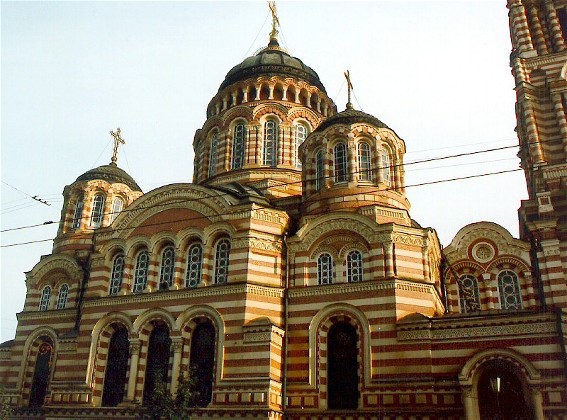
.jpg)
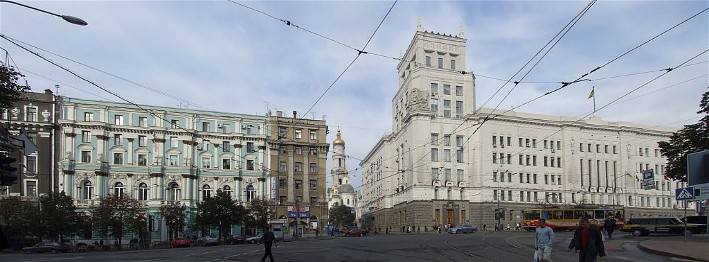
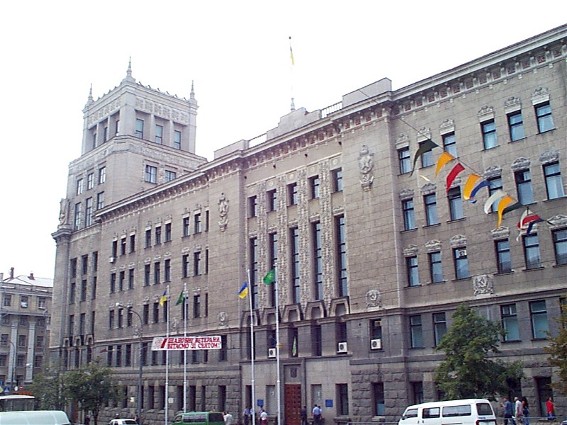
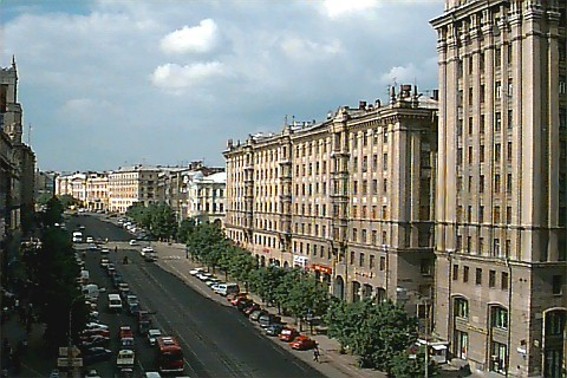
.jpg)
.jpg)
